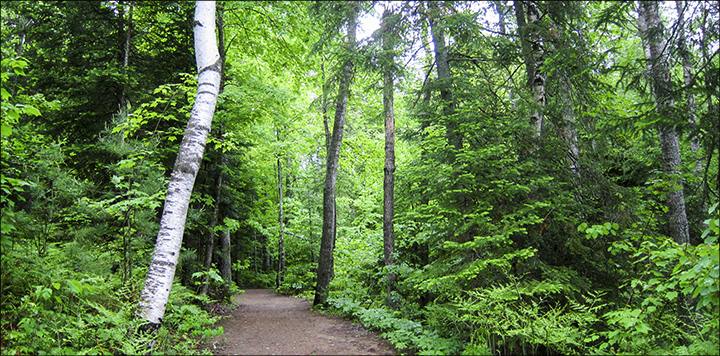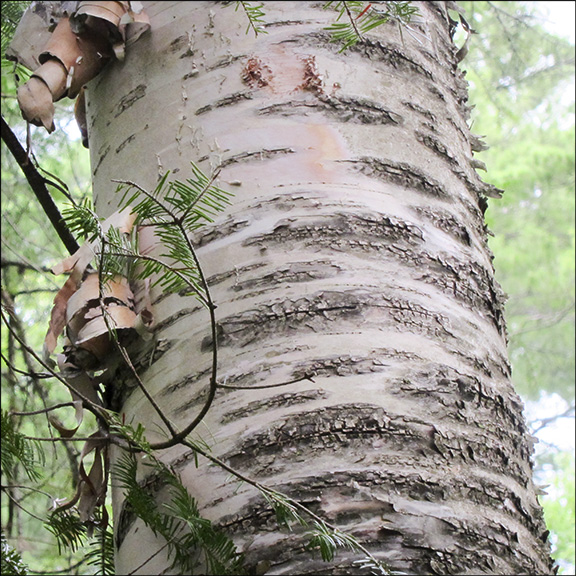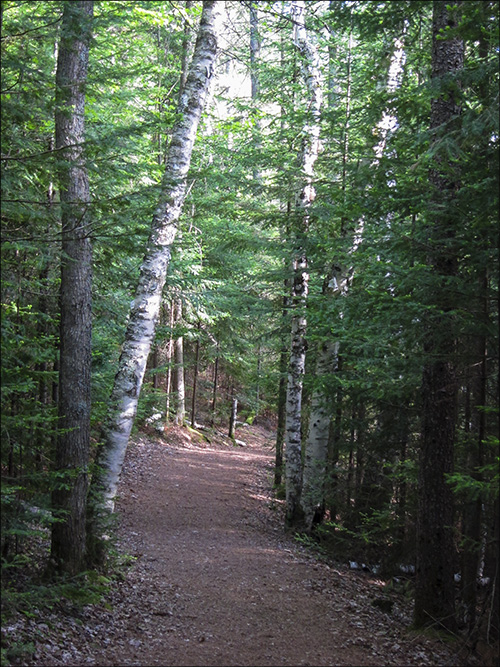Trees of the Adirondacks:
Paper Birch (Betula papyrifera)
 Trees of the Adirondacks: Paper Birch growing in mixed conifer/hardwood forest on the Barnum Brook Trail (2 June 2012).
Trees of the Adirondacks: Paper Birch growing in mixed conifer/hardwood forest on the Barnum Brook Trail (2 June 2012).
| This page is no longer being updated. For an updated and expanded version of this material, see: Paper Birch (Betula papyriferavar.papyrifera). |
The Paper Birch (Betula papyrifera) is a small to medium-sized, fast-growing deciduous tree usually found in mixed hardwood-conifer forests in the northern US and Canada, including the Adirondack Mountains. This tree – a close relative of the Yellow Birch (which also grows in our part of the Adirondacks) – is a member of the Birch family. The Paper Birch is short-lived and rarely lives more than 140 years. This tree is also known as White Birch, Silver Birch, Paperbark Birch, or Canoe Birch. The latter name reflects the use of it bark by native Americans to make canoes.

Identification of the Paper Birch: Paper Birch trees feature a distinctive white bark. The bark of young Paper Birch trees is brownish, but begins to turn white when the tree is about a decade old. The white bark develops paper-like layers. Beneath the loose paper, the tree's inner bark is creamy to pinkish or orangish white. The tree may have dark triangular markings (or chevrons) where the branches have died and fallen off.
The leaves of Paper Birch trees are green in summer, turning yellow in fall. The leaves, which are arranged alternately, are 2 to 5 inches long and one to three inches wide. They are roughly oval in shape, with tapering tips and double-toothed edges which are coarsely double-toothed.
The tiny flowers, borne on catkins, appear in April of May, before or at the same time as the leaves emerge. The yellowish male flowers stand on long, dropping catkins near the twig tip. The green or red female flowers blossom on short, upright catkins father back on the same twig.
The Paper Birch tree's distinctive peeling bark is the main clue to distinguishing it from other deciduous trees in the Adirondacks. The main difficulty is differentiating Paper Birch from Yellow Birch.
- Both Paper Birch and Yellow Birch feature peeling bark. The Paper Birch has bright white bark, the underside of which is a pinkish color. When it peels, the strips are fairly wide, and thick. Yellow Birch bark, by contrast, is more bronze in color; and the bark of the Yellow Birch tends to peel off in thin papery ringlets. This distinction is less helpful in older specimens, when the bark has darkened with age.
- The scent of the stem is another identifier. Scrape a short section of the twig of the birch in question with your fingernail and give it a sniff. If it smells like wintergreen, you probably have a Yellow Birch, rather than a Paper Birch.
Uses of the Paper Birch: This tree is used primarily for specialty products such as ice cream sticks, toothpicks, bobbins, clothespins, spools, broom handles, and toys. The bark is also used by crafters to create decorative items. The handsome foliage and showy white bark make the trees attractive for landscaping. Paper Birch can be tapped in the spring to obtain sap from which syrup, wine, beer, or medicinal tonics can be made.
The Paper Birch was used by a wide variety of native American tribes in many different ways. Paper Birch was used as a remedy for a wide variety of ailments, including burns, rashes, stomach cramps, colds, and coughs. Several groups used the sap to make syrup. The root bark was used as a tea substitute and the inner bark as a dye. The bark was also used to make canoes, baskets, and containers. The wood was used to make canoe paddles, toboggans, and snowshoes.

Wildlife Value of the Paper Birch: Paper Birch trees are an important browse plant for animals. Snowshoe Hares, Moose, Eastern Cottontail, Beaver, and Porcupines eat the twigs or bark. Where winter food is inadequate, Paper Birch trees are also browsed by White-tailed Deer. This tree is the larval host for the Canadian Tiger Swallowtail, Luna Moth, and Mourning Cloak.
Paper Birch trees provide food and breeding habitat for a number of birds. Ruffed Grouse eat the seeds and buds of Paper Birch. The seed-filled catkins also feed Black-capped Chickadees, Common Redpolls, Pine SIskins, and Fox Sparrows. Yellow-belled Sapsuckers chip holes in the bark, returning to feed on the sap that pools in the excavations. Several birds, notably Philadelphia Vireos, Red-shouldered Hawks, and Black-throated Green Warblers, use birch strips for nest construction.
The Paper Birch is a common tree species in the breeding habitat for several species of birds, including:
| Mourning Warbler | Veery |
| Northern Goshawk | Rose-breasted Grosbeak |
| Yellow-bellied Sapsucker | Eastern Whip-poor-will |
| Black-capped Chickadee |
Distribution of the Paper Birch: This species is widely distributed from northwestern Alaska, east across Canada to Labrador and Newfoundland, south in northwestern states to Pennsylvania and Iowa and in the western states to Montana and northeastern Oregon. In New York State, the Paper Birch is found in most of the eastern counties, including the Catskills and the Adirondack Mountains.
Paper Birch trees are commonly found in mixed hardwood-conifer forests, but may form nearly pure stands where they pioneer areas disturbed by fires or logging. This tree grows best in the areas where average summer temperatures are not above 70 degrees. The tree does not perform well in harsh conditions or heat and is not tolerant of pollution.

Paper Birch at the Paul Smiths VIC: Paper Birch trees, like most other deciduous trees in the Adirondacks, prefer relatively well-drained soils. in contrast to Black Spruce and Tamaracks, Paper Birch trees do not grow in the middle of bogs or marshes. Look for Paper Birch along many of the trails at the VIC, growing near Eastern Hemlock, Balsam Fir, and Hobblebush. Wildflowers often observed growing nearby include Wild Sarsaparilla, Canada Mayflower, and Twinflower.
The most convenient place to observe the Paper Birch and compare it with the Yellow Birch and other deciduous trees at the VIC is on the Barnum Brook Trail. This species is one of the eleven tree species marked with signage along this trail. The identified Paper Birch is about half a mile from the entrance gazebo. If you take the left hand fork and walk the trail in a clockwise direction, the tree is just past the second overlook, on the right hand side of the trail, opposite the Eastern Hemlock.
References
- United States Department of Agriculture. Forest Service. Silvics of North America. Paper Birch. Retrieved 16 March 2015.
- United States Department of Agriculture. Paper Birch Plant Guide. Retrieved 16 March 2015.
- Lady Bird Johnson Wildflower Center. Native Plant Database. Retrieved 16 March 2015.
- Online Encyclopedia of Life. Betula papyrifera. Retrieved 16 March 2015.
- New York Flora Association. New York Flora Atlas. Retrieved 16 March 2015.
- University of Michigan. Native American Ethnobotany. A Database of Foods, Drugs, Dyes and Fibers of Native American Peoples, Derived from Plants. Retrieved 16 March 2015.
- Plants for a Future. Database. Retrieved 16 March 2015.
- The Birds of North America. Subscription Web Site. Mourning Warbler, Veery, Northern Goshawk, Ruby-throated Hummingbird, Rose-breasted Grosbeak, Red-Shouldered Hawk, Yellow-bellied Sapsucker, Eastern Whip-poor-will, Northern Goshawk, and Black-capped Chickadee. Retrieved 19 March 2015.
- Butterflies and Moths of North America. Canadian Tiger Swallowtail, Mourning Cloak, and Luna Moth. Retrieved 16 March 2015.
- Ellen Rathbone, "Adirondack Tree Identification 102," The Adirondack Almanack, 18 November 2009. Retrieved 16 March 2015.
- Trees of the Northern Forest Trail Walk
- New York State Department of Environmental Conservation. Winter Deer Foods. Retrieved 16 March 2015.
- Paul Smith’s College VIC. Barnum Brook Tree Game.
- George A. Petrides. A Field Guide to Eastern Trees (Boston: Houghton Mifflin Company, 1998), pp. 100-101, 313-314.
- George A. Petrides. A Field Guide to Trees and Shrubs (Boston: Houghton Mifflin Company, 1958,1972), pp. 231-232, 338-339.
- Gil Nelson, Christopher J. Earle, and Richard Spellenberg. Trees of Eastern North America (Princeton : Princeton University Press), pp. 154-155.
- C. Frank Brockman. Trees of North America (New York: St. Martin's Press), pp. 102-103.
- Keith Rushforth and Charles Hollis. Field Guide to the Trees of North America (Washington, D.C., National Geographic, 2006), p. 109.
- National Audubon Society. Field Guide to North American Trees. Eastern Region. (New York: Alfred A. Knopf, 1980), Plates 179, 615, pp. 368-369.
- John Kricher. A Field Guide to Eastern Forests. North America (Boston: Houghton Mifflin, 1998), pp. 62-67, 122-123.
- Alexander C. Martin, Herbert S. Zim, and Arnold L. Nelson. A Guide to Wildlife Food Habits (New York: Dover Publications, 1951), pp. 304-305.
- Bruce Kershner, et al. National Wildlife Federation Field Guide to Trees of North America (New York: Sterling Publishing Co., 2008), pp. 399, 402.
- John Eastman. The Book of Forest and Thicket. Trees, Shrubs, and Wildflowers of Eastern North America (Harrisburg, Pennsylvania, 1992), pp. 25-30.
- David Allen Sibley. The Sibley Guide to Trees (New York: Alfred A. Knopf, 2009), pp.150-151.
- Charles Fergus. Trees of Pennsylvania and the Northeast (Mechanicsburg, Pennsylvania: Stackpole Books, 2002), pp. 89-92.
